Bapineuzumab alters aβ composition: implications for the amyloid cascade hypothesis and anti-amyloid immunotherapy
- PMID: 23555764
- PMCID: PMC3605408
- DOI: 10.1371/journal.pone.0059735
Bapineuzumab alters aβ composition: implications for the amyloid cascade hypothesis and anti-amyloid immunotherapy
Abstract
The characteristic neuropathological changes associated with Alzheimer's disease (AD) and other lines of evidence support the amyloid cascade hypothesis. Viewing amyloid deposits as the prime instigator of dementia has now led to clinical trials of multiple strategies to remove or prevent their formation. We performed neuropathological and biochemical assessments of 3 subjects treated with bapineuzumab infusions. Histological analyses were conducted to quantify amyloid plaque densities, Braak stages and the extent of cerebral amyloid angiopathy (CAA). Amyloid-β (Aβ) species in frontal and temporal lobe samples were quantified by ELISA. Western blots of amyloid-β precursor protein (AβPP) and its C-terminal (CT) fragments as well as tau species were performed. Bapineuzumab-treated (Bapi-AD) subjects were compared to non-immunized age-matched subjects with AD (NI-AD) and non-demented control (NDC) cases. Our study revealed that Bapi-AD subjects exhibited overall amyloid plaque densities similar to those of NI-AD cases. In addition, CAA was moderate to severe in NI-AD and Bapi-AD patients. Although histologically-demonstrable leptomeningeal, cerebrovascular and neuroparenchymal-amyloid densities all appeared unaffected by treatment, Aβ peptide profiles were significantly altered in Bapi-AD subjects. There was a trend for reduction in total Aβ42 levels as well as an increase in Aβ40 which led to a corresponding significant decrease in Aβ42:Aβ40 ratio in comparison to NI-AD subjects. There were no differences in the levels of AβPP, CT99 and CT83 or tau species between Bapi-AD and NI-AD subjects. The remarkable alteration in Aβ profiles reveals a dynamic amyloid production in which removal and depositional processes were apparently perturbed by bapineuzumab therapy. Despite the alteration in biochemical composition, all 3 immunized subjects exhibited continued cognitive decline.
Conflict of interest statement
Figures
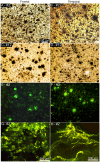
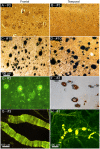


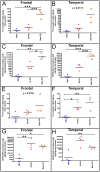

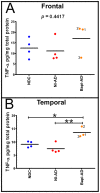
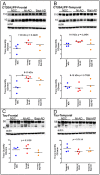
Similar articles
-
Neuropathology and amyloid-β spectrum in a bapineuzumab immunotherapy recipient.J Alzheimers Dis. 2011;24(2):315-25. doi: 10.3233/JAD-2011-101809. J Alzheimers Dis. 2011. PMID: 21263194 Free PMC article.
-
Chemical and neuropathological analyses of an Alzheimer's disease patient treated with solanezumab.Am J Neurodegener Dis. 2016 Aug 26;5(4):158-170. eCollection 2016. Am J Neurodegener Dis. 2016. PMID: 27725918 Free PMC article.
-
Alzheimer's disease and non-demented high pathology control nonagenarians: comparing and contrasting the biochemistry of cognitively successful aging.PLoS One. 2011;6(11):e27291. doi: 10.1371/journal.pone.0027291. Epub 2011 Nov 7. PLoS One. 2011. PMID: 22087282 Free PMC article.
-
Immunotherapy for Alzheimer's disease: from anti-β-amyloid to tau-based immunization strategies.Immunotherapy. 2012 Feb;4(2):213-38. doi: 10.2217/imt.11.170. Immunotherapy. 2012. PMID: 22339463 Review.
-
Are N- and C-terminally truncated Aβ species key pathological triggers in Alzheimer's disease?J Biol Chem. 2018 Oct 5;293(40):15419-15428. doi: 10.1074/jbc.R118.003999. Epub 2018 Aug 24. J Biol Chem. 2018. PMID: 30143530 Free PMC article. Review.
Cited by
-
Immunotherapy targeting pyroglutamate-3 Aβ: prospects and challenges.Mol Neurodegener. 2016 Jun 30;11(1):48. doi: 10.1186/s13024-016-0115-2. Mol Neurodegener. 2016. PMID: 27363697 Free PMC article. Review.
-
Cerebral amyloid PET imaging in Alzheimer's disease.Acta Neuropathol. 2013 Nov;126(5):643-57. doi: 10.1007/s00401-013-1185-7. Epub 2013 Oct 8. Acta Neuropathol. 2013. PMID: 24100688 Free PMC article. Review.
-
Phage display and kinetic selection of antibodies that specifically inhibit amyloid self-replication.Proc Natl Acad Sci U S A. 2017 Jun 20;114(25):6444-6449. doi: 10.1073/pnas.1700407114. Epub 2017 Jun 5. Proc Natl Acad Sci U S A. 2017. PMID: 28584111 Free PMC article.
-
Clinical Neuropathological Analysis of 10 Cases of Cerebral Amyloid Angiopathy-Related Cerebral Lobar Hemorrhage.J Korean Neurosurg Soc. 2015 Jul;58(1):30-5. doi: 10.3340/jkns.2015.58.1.30. Epub 2015 Jul 31. J Korean Neurosurg Soc. 2015. PMID: 26279810 Free PMC article.
-
Basal lamina changes in neurodegenerative disorders.Mol Neurodegener. 2021 Dec 7;16(1):81. doi: 10.1186/s13024-021-00502-y. Mol Neurodegener. 2021. PMID: 34876200 Free PMC article. Review.
References
-
- Pul R, Dodel R, Stangel M (2011) Antibody-based therapy in Alzheimer’s disease. Expert Opin Biol Ther 11: 343–357. - PubMed
Publication types
MeSH terms
Substances
Grants and funding
LinkOut - more resources
Full Text Sources
Other Literature Sources
Miscellaneous

